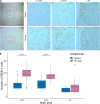High-frequency hearing in a hummingbird
- PMID: 32832648
- PMCID: PMC7439503
- DOI: 10.1126/sciadv.abb9393
High-frequency hearing in a hummingbird
Abstract
Some hummingbirds produce unique high-frequency vocalizations. It remains unknown whether these hummingbirds can hear these sounds, which are produced at frequencies beyond the range at which most birds can hear. Here, we show behavioral and neural evidence of high-frequency hearing in a hummingbird, the Ecuadorian Hillstar (Oreotrochilus chimborazo). In the field, hummingbirds responded to playback of high-frequency song with changes in body posture and approaching behavior. We assessed neural activation by inducing ZENK expression in the brain auditory areas in response to the high-frequency song. We found higher ZENK expression in the auditory regions of hummingbirds exposed to the high-frequency song compared to controls, while no difference was observed in the hippocampus between groups. The behavioral and neural responses show that this hummingbird can hear sounds at high frequencies. This is the first evidence of the use of high-frequency vocalizations and high-frequency hearing in conspecific communication in a bird.
Copyright © 2020 The Authors, some rights reserved; exclusive licensee American Association for the Advancement of Science. No claim to original U.S. Government Works. Distributed under a Creative Commons Attribution NonCommercial License 4.0 (CC BY-NC).
Figures



References
-
- J. W. Bradbury, S. L. Vehrencamp, Principles of Animal Communication (Sinauer Associates, ed. 2, 2011).
-
- R. H. Wiley, in Animal Communication and Noise, H. Brumm, Ed. (Springer Berlin Heidelberg, 2013), vol. 2, pp. 7–30.
-
- Ryan M. J., Fox J. H., Wilczynski W., Rand A. S., Sexual selection for sensory exploitation in the frog Physalaemus pustulosus. Nature 343, 66–67 (1990). - PubMed
-
- Duque F. G., Rodríguez-Saltos C. A., Wilczynski W., High-frequency vocalizations in Andean hummingbirds. Curr. Biol. 28, R927–R928 (2018). - PubMed
-
- R. Dooling, in Nature’s Music: The Science of Birdsong, H. Slabbekoorn, P. R. Marler, Eds. (Elsevier Academic Press, 2004), pp. 206–225.
Publication types
LinkOut - more resources
Full Text Sources

